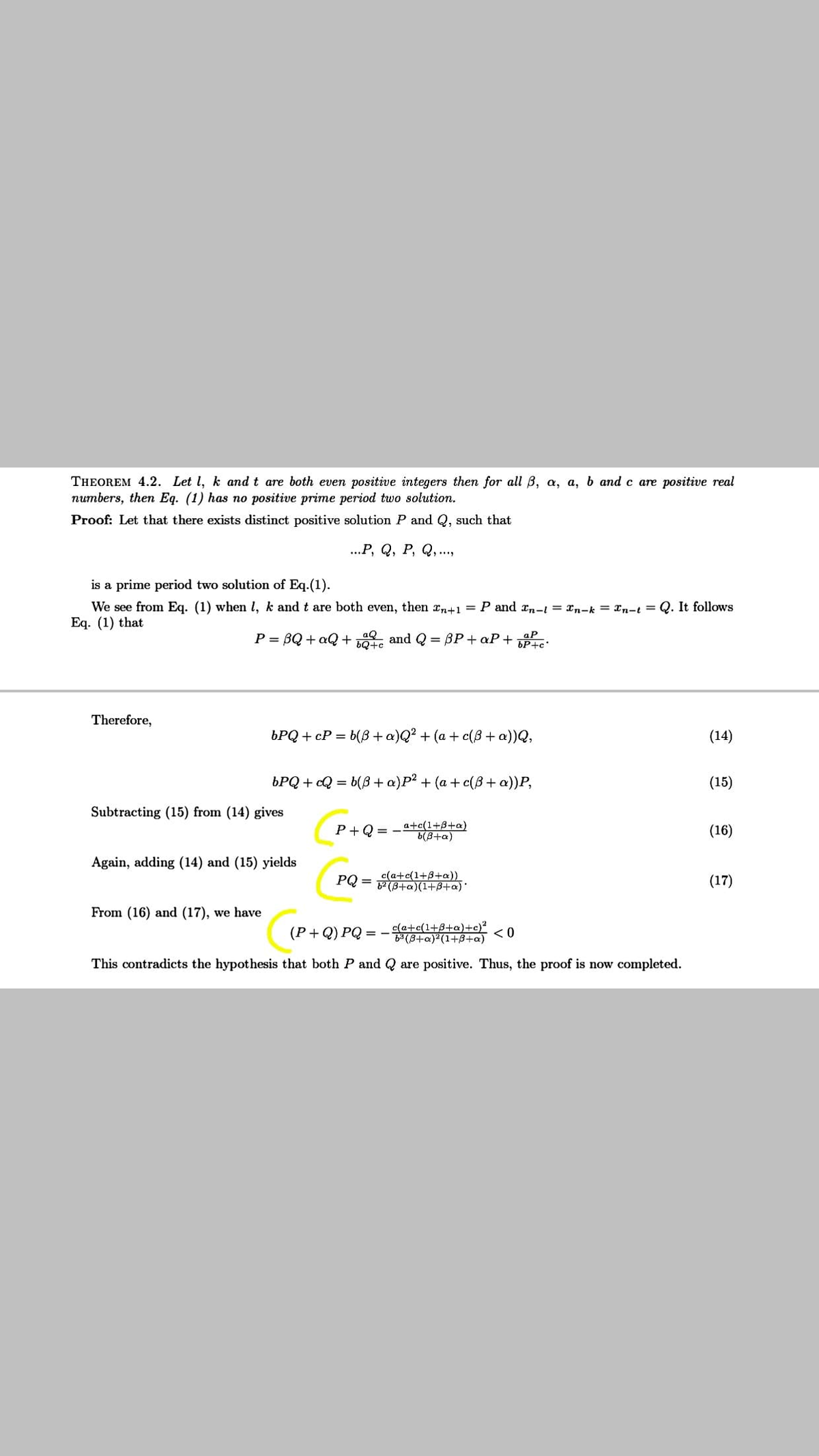THEOREM 4.2. Let l, k and t are both even positive integers then for all B, a, a, b and c are positive real numbers, then Eq. (1) has no positive prime period two solution. Proof: Let that there exists distinct positive solution P and Q, such that ....Р, Q, Р, Q, ..., is a prime period two solution of Eq.(1). We see from Eq. (1) when l, k and t are both even, then rn+1 = P and rn-l = xn-k = xn-t = Q. It follows Eq. (1) that P = BQ + aQ + 1. and Q = BP+ aP+ . 6P+c* Therefore, bPQ + cP = b(B +a)Q? + (a + c(B+a))Q, (14) bPQ + cQ = b(B+a)P² + (a + c(B + a))P, (15) Subtracting (15) from (14) gives P+Q = a+c(1+8+a) b(8+a) (16) Again, adding (14) and (15) yields PQ = c(a+c(1+3+a)). (B+a)(1+B+a) (17) From (16) and (17), we have (P+Q) PQ c(a+c(1+B+a)+c)² b (8+a)²(1+B+a) < 0 = - This contradicts the hypothesis that both P and Q are positive. Thus, the proof is now completed.
THEOREM 4.2. Let l, k and t are both even positive integers then for all B, a, a, b and c are positive real numbers, then Eq. (1) has no positive prime period two solution. Proof: Let that there exists distinct positive solution P and Q, such that ....Р, Q, Р, Q, ..., is a prime period two solution of Eq.(1). We see from Eq. (1) when l, k and t are both even, then rn+1 = P and rn-l = xn-k = xn-t = Q. It follows Eq. (1) that P = BQ + aQ + 1. and Q = BP+ aP+ . 6P+c* Therefore, bPQ + cP = b(B +a)Q? + (a + c(B+a))Q, (14) bPQ + cQ = b(B+a)P² + (a + c(B + a))P, (15) Subtracting (15) from (14) gives P+Q = a+c(1+8+a) b(8+a) (16) Again, adding (14) and (15) yields PQ = c(a+c(1+3+a)). (B+a)(1+B+a) (17) From (16) and (17), we have (P+Q) PQ c(a+c(1+B+a)+c)² b (8+a)²(1+B+a) < 0 = - This contradicts the hypothesis that both P and Q are positive. Thus, the proof is now completed.
Algebra & Trigonometry with Analytic Geometry
13th Edition
ISBN:9781133382119
Author:Swokowski
Publisher:Swokowski
Chapter10: Sequences, Series, And Probability
Section10.4: Mathematical Induction
Problem 42E
Related questions
Question
Show me the determine yellow and the information is here

Transcribed Image Text:THEOREM 4.2. Let l, k and t are both even positive integers then for all B, a, a, b and c anre positive real
numbers, then Eq. (1) has no positive prime period two solution.
Proof: Let that there exists distinct positive solution P and Q, such that
...P, Q, P, Q,.,
is a prime period two solution of Eq.(1).
We see from Eq. (1) when l, k and t are both even, then rn+1 = P and rn-t = xn-k = Xn-t = Q. It follows
Eq. (1) that
P = BQ + aQ + andQ = BP + aP+P
¿P+c°
aQ
bQ+c
Therefore,
bPQ + cP = b(B +a)Q? + (a + c(8 + a))Q,
(14)
bPQ + cQ = b(B+ a)P? + (a + c(B + a))P,
(15)
Subtracting (15) from (14) gives
P+Q
a+c(1+8+a)
b(B+a)
(16)
Again, adding (14) and (15) yields
PQ
c(a+c(1+8+a))
62 (8+a)(1+3+a)
(17)
From (16) and (17), we have
(P+Q) РQ 3 -
e(a+c(1+8+a)+c)²
<0
(8+a)²(1+8+a)
This contradicts the hypothesis that both P and Q are positive. Thus, the proof is now completed.

Transcribed Image Text:Our goal is to obtain some qualitative behavior of the positive solutions of the difference equation
aIn-t
In+1 = Bxn-i+axn-k +
п%3D 0, 1,
(1)
bxn-t+c'
where the parameters B, a, a, b and c are positive real numbers and the initial conditions x-s, x-s+1,..., x-1,
xo are positive real numbers where s =
таxfl, k, t).
Expert Solution
This question has been solved!
Explore an expertly crafted, step-by-step solution for a thorough understanding of key concepts.
Step by step
Solved in 3 steps with 3 images

Recommended textbooks for you

Algebra & Trigonometry with Analytic Geometry
Algebra
ISBN:
9781133382119
Author:
Swokowski
Publisher:
Cengage

Linear Algebra: A Modern Introduction
Algebra
ISBN:
9781285463247
Author:
David Poole
Publisher:
Cengage Learning

Elements Of Modern Algebra
Algebra
ISBN:
9781285463230
Author:
Gilbert, Linda, Jimmie
Publisher:
Cengage Learning,

Algebra & Trigonometry with Analytic Geometry
Algebra
ISBN:
9781133382119
Author:
Swokowski
Publisher:
Cengage

Linear Algebra: A Modern Introduction
Algebra
ISBN:
9781285463247
Author:
David Poole
Publisher:
Cengage Learning

Elements Of Modern Algebra
Algebra
ISBN:
9781285463230
Author:
Gilbert, Linda, Jimmie
Publisher:
Cengage Learning,